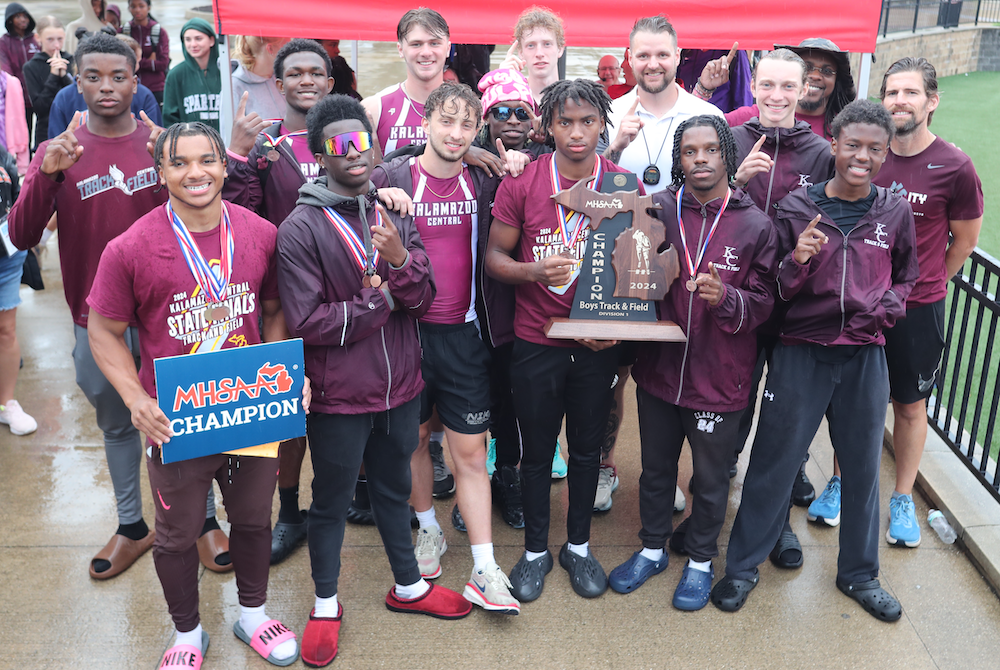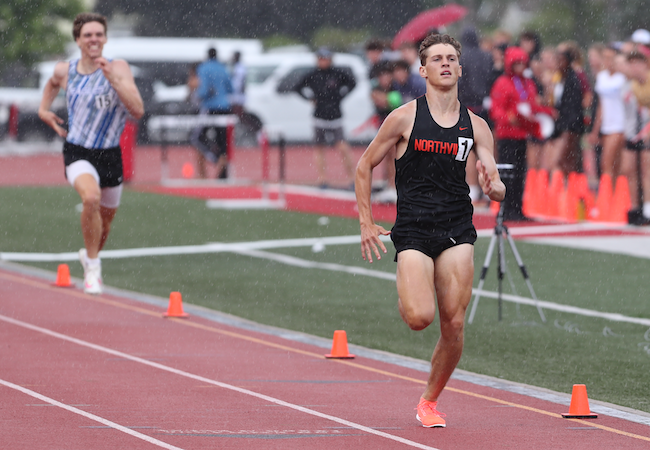
Add, Subtract, Divide, Multiply: MHSAA Not Alone
July 25, 2017
By Rob Kaminski
MHSAA benchmarks editor
This is the third part in a series on MHSAA tournament classification, past and present, that will be published over the next two weeks. This series originally ran in this spring's edition of MHSAA benchmarks.
As the MHSAA faces its most recent classification task with 8-Player Football, and opinions continue to swirl about as to the method, timeframe, location and other procedures, a look around the country provides plenty of company among state association brethren factoring variables into their own equations.
In the Pacific Northwest, the Oregon School Activities Association Football Playoffs are under public scrutiny as leadership ponders a five or six classification format beginning with the 2018-19 school year.
The OSAA has crowned six champions on the gridiron since 2006-07. Many of the state’s smaller schools would like to keep it that way, while larger schools lean toward a five-classification system, citing larger leagues, ease of travel and credibility to state championships as the advantages.
Still others would prefer more than six classes, pointing to safety issues and the opportunity to increase participation numbers as positives.
Moving southeast of Oregon, the Nevada Interscholastic Activities Association recently voted to hold serve on a classification proposal that was volleyed to the membership.
However, changes still could be forthcoming by as early as the 2018-19 season which would add a fifth classification in more populated southern Nevada while allowing northern schools to participate in four classifications. Such divisions could mean no state championship for the fifth class in southern Nevada.
Because of that, the NIAA wants equal numbers of schools in each classification on both ends of the state. Complicating the issue is the fact that the 24 largest schools in the state, by enrollment, are all in Clark County in Southern Nevada.
Across Nevada’s border into Arizona, charter schools are asking the Arizona Interscholastic Association to reconsider classification that was voted upon and approved in September 2015. That agreement called for the largest 33 percent of charter schools by enrollment to be placed in the state’s largest school classification, 3A, the middle 33 percent into 2A, and the smallest 33 percent into 1A.
Less than two years later the charter schools have had a change of heart and have asked to be considered the same as other Arizona public schools and be placed appropriately by enrollment beginning with the 2018-19 school year.
The situation in Arizona further illustrates how the public/private debate that all state associations have faced throughout existence now has the added dynamic of rapidly growing charter schools in today’s educational system, along with virtual school enrollment.
In the nation’s heartland, Nebraska has retooled its football classifications by using enrollment of boys students only in its schools rather than total enrollment. The Nebraska School Activities Association football-playing schools will kick off the 2018 season using this alignment.
Nebraska has three classes of 11-player football, with the smallest class divided in two, Class C-1 and C-2. The state also will have 8-player football for boys enrollments under 47, and the NSAA will sponsor a new 6-player tournament in 2018 for schools with 27 or fewer boys.
“This is a good proposal because some schools have a sizable imbalance between the number of boys and girls, and there’s a large gap (in enrollment) between the largest and smallest schools in Classes A and B,” NSAA executive director Jim Tenopir said. “I think this addresses both of those concerns.”
Swimmers in Georgia, meanwhile, will feel like they are moving with the current, rather than upstream in 2017-18, as the Georgia High School Association recently doubled the number of team championship events from two to four.
Swim enthusiasts can also count on longer days at the finals, as the top 30 finishers from the prelims will advance to the finals instead of 20, and all championship events will have three heats versus two.

Kalamazoo Central Headlines LPD1 Finals with 1st Championship since 1965
By
Steve Vedder
Special for MHSAA.com
June 2, 2024
KENTWOOD – Garrett Weeden figures that condensing a four-year dream to a single, all-or-nothing throw is not the easiest way to win a state championship.
But that was the unlikely storyline for Weeden in Saturday's shot put at the MHSAA Lower Peninsula Division 1 Finals at East Kentwood. With one throw left for him in the shot put, the Zeeland East senior was staring at a runner-up finish behind Walled Lake Central leader Tyler Marrogy, whose toss of 58 feet, 2 inches had topped the field.
What's worse is that Weeden freely admits there were past moments during his throwing career when he wouldn't have exactly – well, let's say – risen to the occasion.
All that was rushing through Weeden's mind before he stepped up with a last-ditch throw of 59 feet to win the event. Weeden has been in the hunt for a Finals title in the past, with a ninth place in the shot (and a sixth in the discus) a year ago, but the main prize had always eluded him. That is, until his last throw Saturday.
"I know I needed around a 58-4 and that I had thrown a 59-1 once at an indoor meet," said Weeden, whose previous outdoor best was a 57-7. I wasn't thinking about technique or anything, I just got into it and threw. I just put it all out there.
"I used to be the kind of guy who didn't do well in situations like that. But I've gone to a lot of big meets that have given me confidence. I just knew I needed to step up and do it."
While Weeden's clutch throw was one of the best stories from the individual portion of the meet, Kalamazoo Central narrowly won a wild three-team race for first place. The Maroon Giants finished first with 41 points, just ahead of 39 by Clinton Township Chippewa Valley and 38 by Belleville. Grand Haven was fourth with 29 points, and Ann Arbor Huron had 26.
Kalamazoo Central coach Tyler Germain, whose team won its first Finals title since 1965, said he told his athletes the victory was possible.
"I told them maybe because I knew they could compete," he said. "I told them anything can happen, We just went out and competed; we ran real well. We weren't overconfident or anything, but we have a good, competitive group that I've seen grow up."
 Kalamazoo Central wound up placing in six events, with a first by junior Jeremy Dixon in the 100 (10.72).
Kalamazoo Central wound up placing in six events, with a first by junior Jeremy Dixon in the 100 (10.72).
Four-year senior Latay'vion Braxton admitted that while his teammates listened closely to their coach's prediction, there was at least a trickle of doubt in the runners' minds at the start of the season.
"I don't think I felt like it was really in the plan," he said. "I don't know that we thought it would happen. But some of us grew up together, and we thought maybe this was the time to do it."
Among the most dominating showings in the meet were a pair of firsts in the 200 (21.36) and 400 (46.76) by Chippewa Valley's Shamar Heard. The University of Tennessee-bound Heard finishes an outstanding career with three Finals titles in the 200, two in the 400 and one in the 100. He also helped the 1,600 relay to a first (3:17.51) on Saturday.
"After my breakout year as a sophomore, I knew what I could do," he said. "I quit the 100, but still won as part of a (relay) team. It's been a challenge mentally and physically, but with repetition you learn to trust the process."
Among the other victories was a first place in the pole vault (15-3) by East Kentwood sophomore Reece Emeott, the son of Falcons coach Dave Emeott. Reese said he's been dreaming of a state championship in the pole vault since attending his father's offseason pole vault camp as a middle schooler.
"That's always been the goal; I've been working toward it since I was a little kid," he said. "I was the No. 1 seed, and I've been unbeaten the last couple months so I thought I'd have a chance. I just needed to be consistent. I knew I was good enough. I just had to execute."
Grand Haven senior Seth Norder won the 1,600 (4:03.01). He was the runner-up in that event two years ago and then spent more time in the 3,200 in 2023. Seven of the eight runners in the 1,600 ran personal bests, including Norder.
"I didn't like where my speed was so I worked on it," he said. "I knew this was a good field as the guys who finished second and third will be teammates with me at Michigan State next year. I thought I ran well."
Northville senior Brendan Herger gained a huge measure of satisfaction when he won the 800 (1:50.08). He finished runner-up in the event a year ago when he lagged down the stretch. This year Herger found himself in much the same situation, but lessons learned a year ago led to different results Saturday.
"I thought I had it last year, and it was a big disappointment," said Herger, who will compete in the upcoming New Balance nationals. "But that was only fuel for the fire this year. (Finishing second) actually helped me. This year I closed faster."
Relay winners on Saturday included Holland West Ottawa in the 800 (1:25.53) and 400 (41.35) and Northville in the 3,200 (7:44.52).
Individually, Schmar Gamble of Belleville won the 110 hurdles (13.85), Leonardo Peralta-Castro of Lincoln Park the 300 hurdles (37.93), Thomas Westphal of New Baltimore Anchor Bay the 3,200 (9:07.56), Isaac Quincy of Canton the long jump (23-3¾), Brock Fergison of Sturgis the high jump (6-10) and Clinton Allen of Grosse Pointe North the discus (177-3). Anchor Bay junior Luke Bowman won the adaptive 200, 400 and shot put events, and South Lyon freshman Owen Moerdyke won the adaptive 100 race.
PHOTOS (Top) Kalamazoo Central celebrates its first Finals championship Saturday since 1965. (Middle) Northville’s Brendan Herger pulls away for the win in the 800. (Click for more from John Brabbs/RunMichigan.com.)

